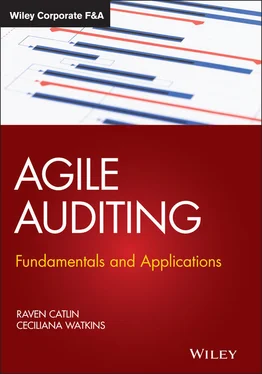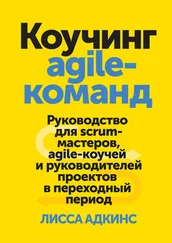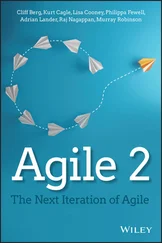Raven Catlin - Agile Auditing
Здесь есть возможность читать онлайн «Raven Catlin - Agile Auditing» — ознакомительный отрывок электронной книги совершенно бесплатно, а после прочтения отрывка купить полную версию. В некоторых случаях можно слушать аудио, скачать через торрент в формате fb2 и присутствует краткое содержание. Жанр: unrecognised, на английском языке. Описание произведения, (предисловие) а так же отзывы посетителей доступны на портале библиотеки ЛибКат.
- Название:Agile Auditing
- Автор:
- Жанр:
- Год:неизвестен
- ISBN:нет данных
- Рейтинг книги:5 / 5. Голосов: 1
-
Избранное:Добавить в избранное
- Отзывы:
-
Ваша оценка:
- 100
- 1
- 2
- 3
- 4
- 5
Agile Auditing: краткое содержание, описание и аннотация
Предлагаем к чтению аннотацию, описание, краткое содержание или предисловие (зависит от того, что написал сам автор книги «Agile Auditing»). Если вы не нашли необходимую информацию о книге — напишите в комментариях, мы постараемся отыскать её.
Machine learning Virtual Conferencing Process automation Data analytics Hugely popular in software development, the agile approach is just making its way into the field of audit. This book provides concrete examples and practical solutions for auditors who seek to implement agile techniques and methods.
Agile Auditing
Agile Auditing — читать онлайн ознакомительный отрывок
Ниже представлен текст книги, разбитый по страницам. Система сохранения места последней прочитанной страницы, позволяет с удобством читать онлайн бесплатно книгу «Agile Auditing», без необходимости каждый раз заново искать на чём Вы остановились. Поставьте закладку, и сможете в любой момент перейти на страницу, на которой закончили чтение.
Интервал:
Закладка:
In a virtual environment, internal auditors face myriad challenges in how they address and complete their work, from different methods of communications to limitations on travel and physical access. The pandemic has certainly tested the concept of Agile auditing, but the good news is that, amid a changing risk landscape, we've learned that it actually can be most effective.
I met Raven Catlin in 2002 at The IIA's Volunteer Instructor Development Program. Raven stood out. She successfully completed the program and impressed me as a knowledgeable, articulate, experienced, and innovative auditor. As an instructor, Raven presents an effective method to deliver concepts and influence others to adopt new practices. This book showcases those attributes. It offers a framework for audit functions to add value and remain relevant. I find Raven and Ceciliana's Agile audit framework to be distinct in that it is not a method that simply provides ideas. It is truly a framework that's adaptable and allows audit teams to incorporate practices and tools into an Agile audit methodology they create and customize.
Moreover, the framework provides a structure and guidance for greater collaboration with audit customers/clients, a critical tenet of internal auditing. It integrates clients as members of the team from day one, and it acknowledges that, without this fully involved engagement, the audit cannot proceed as an Agile audit. Further, the framework focuses on creating value from the audit client's perspective. It centers the Agile audit on the value proposition, which makes achieving organizational objectives a foundation point.
It also helps organizations increase overall resiliency, which is critical in this new normal. The audit must deliver results more quickly and provide insights that will help reduce detrimental risks and achieve objectives. The flexibility provided by implementing this Agile approach helps management and auditors collaborate in risk identification, resulting in better‐managed businesses and organizations. A vital aspect of this framework is that it uses a risk universe, rather than an audit universe, to determine priorities and an Agile audit plan.
As I have discussed in many of my blogs, tweets, and books, adapting and keeping an eye out for the most critical risk is crucial for our profession and our organizations. Continuous risk thinking is a lesson I learned early in my career and is vital to Agile auditing success. Conventional planning for internal auditing doesn't hold up in today's environment because it cannot deal with unexpected risks.
In 1990, I was in the middle of an old‐school, annual plan as chief audit executive for the U.S. Army when Iraq invaded Kuwait. Risks that very few saw coming had suddenly appeared. I had to toss my annual audit plan and assess risks continuously, so that I could identify and reset our internal audit priorities. Traditional methods and routines of conducting audits based on plans that are six months to a year old are in the past. We need to assess risk continuously, and we must have new information to keep our audit plan up to date.
I wish that I had had this book back in 1990 as a guide not only for myself but also for my audit department and colleagues. The framework and information provided in this book provide the tools and ideas to spark your creative juices to make your audit activities successful today and in the future. In turn, it will allow you to continuously set your antenna high and be better prepared to address new risks as they emerge within our industry and in the overall economy.
Finally, one of the most valuable lessons you will learn in this book is to deliver focused results faster. As presented in the framework, auditors complete each Agile audit in short, two‐week cycles – planning, performing, and communicating risk‐focused results. Applying Agile auditing consistently and maintaining a tight delivery cycle require innovative thinking on audit processes and deliverables. It creates a baseline, so each auditor and each team can measure their performance and become better and stronger with every audit.
I highly recommended Agile Auditing: Fundamentals and Applications by Raven Catlin and Ceciliana Watkins whether you are a seasoned auditor, new to the profession, or even in a different domain unrelated to audit. You will find that the framework, lessons, and principles better equip you to meet new challenges. This book is one of few written by audit professionals to improve our audit services and value to our organizations by being more responsive and a better team player. Reading this book will prepare you with the knowledge and skills necessary to become an Agile auditor, implement Agile auditing in your audit activity, and deliver more value to the organizations you serve.
—Richard Chambers
President and CEO of The Institute of Internal Auditors (IIA) January 2009 to March 2021
Author, Lessons Learned on the Audit Trail (2014), Trusted Advisors:Key Attributes of Outstanding Internal Auditors (2017), and The Speed of Risk: Lessons Learned on the Audit Trail , 2nd edition (2019)
Preface
From the beginning, it seemed natural that Ceciliana Watkins and I would form a friendship. We think alike as auditors, respect each other immensely, and have a passion for learning and sharing knowledge, not to mention sharing a huge passion for cooking and experimenting with “recipes.” On a warm summer night in 2011, just outside of Sacramento, California, we had dinner and talked about some of the pains and frustrations that we experienced in auditing. One of our frustrations is that many auditors work on multiple projects simultaneously and miss deadlines far too frequently. We continued our evening recognizing that we had to determine and fix the root causes of our problems, including audit clients (commonly referred to as “auditees”) frequently failing to deliver evidence when needed, constant and often unconscious scope creep, excessive audit workpaper documentation, and wordsmithing masked as elegant writing consistently clouding the message we really need to deliver to add value, improve processes, and help our organizations accomplish their objectives.
Please understand, my friend and co‐author Ceciliana is a life‐long learner, creator, and challenger. She is a project management professional and has dedicated her professional life to auditing. She challenges others to think better and do more to help improve the audit profession. As we discussed many audit‐related frustrations, my dearest friend asked, “have you ever researched Agile project management?” It was that dinner conversation, over home‐cooked corn tortillas, ceviche, and watermelon‐basil margaritas, that started my Agile auditing journey. On the plane back to Virginia, I started listing the problems faced in the audit process. The very next day, I purchased my first book on Agile and began learning about Agile, including Scrum and other frameworks. Moreover, I started tackling the list of frustrations and mapping Agile practices to the problems in a quest for solutions. I began the journey seeking answers to these questions:
Can the auditing profession use Agile frameworks?
How can auditing adopt Agile principles?
How can Agile tools help fix our audit process problems?
What needs to change in audit to be Agile?
What is the root cause of the audit problems and frustrations?
Can Agile frameworks and principles solve the root causes of our audit problems and symptoms?
I talked with Ceciliana about our journey, questions, and early conclusions. We realized that many of our problems are just symptoms of a root cause, poor audit client relationships. So, we looked for opportunities to use Agile frameworks to help resolve client relationship issues.
Читать дальшеИнтервал:
Закладка:
Похожие книги на «Agile Auditing»
Представляем Вашему вниманию похожие книги на «Agile Auditing» списком для выбора. Мы отобрали схожую по названию и смыслу литературу в надежде предоставить читателям больше вариантов отыскать новые, интересные, ещё непрочитанные произведения.
Обсуждение, отзывы о книге «Agile Auditing» и просто собственные мнения читателей. Оставьте ваши комментарии, напишите, что Вы думаете о произведении, его смысле или главных героях. Укажите что конкретно понравилось, а что нет, и почему Вы так считаете.











